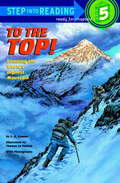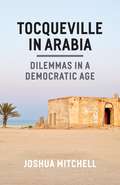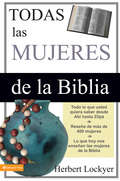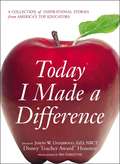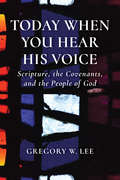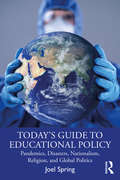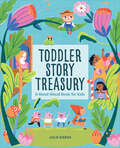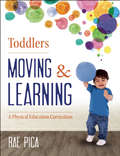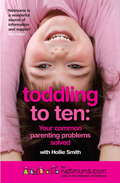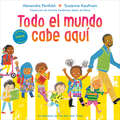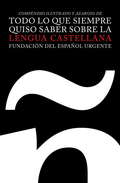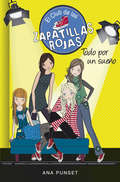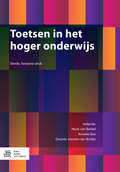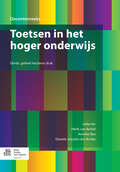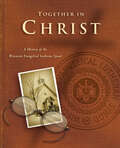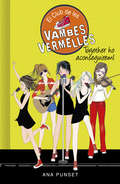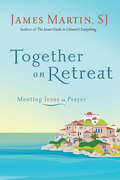- Table View
- List View
To the Top!: Climbing The World's Highest Mountain (Step into Reading #Vol. 5)
by Sydelle KramerIllus. in full color. Here is the gripping story of Hillary and Norgay's perilous ascent of Mount Everest as they battled snow and ice slides, whipping winds, and the grim knowledge that 19 others had died in the same attempt.
Toby Goes Bananas: A Graphic Novel
by Franck GirardToby is last in class but first on the playground!Toby may be the class clown, but he's smart enough to know what's what. Whether he's late for school, early for recess, or just in time to fail the next quiz, he's always got something to say about it. But even though his friends think he's funny, the adults in his life aren't laughing--mostly because they're not in on the jokes. No matter! Toby makes the best of it as he coasts through the day on his wit and good humor!
Tocar la guitarra sin saber solfeo
by Cesare Regazzoni* Los acordes son la base del acompañamiento musical. Una vez los haya aprendido, usted podrá desarrollar su técnica con mucha más seguridad y rapidez. Interpretar una melodía o acompañar a un cantante le será muy fácil. * En esta guía usted encontrará todos los acordes y sus respectivos «giros» o combinaciones, representados en sencillas ilustraciones en las que podrá reconocer fácilmente las cuerdas de la guitarra y la posición de los dedos. No encontrará ni un solo pentagrama, ni una nota, porque estas páginas están pensadas para que cualquier persona, aun no sabiendo solfeo, pueda aprender a tocar la guitarra. * Lo importante en este libro no es la teoría, sino la práctica, por ello sólo se dan las indicaciones más útiles y eficaces. * Un manual, en resumidas cuentas, que le ayudará a dar los primeros pasos con el instrumento más adecuado para animar las fiestas, acompañar a los amigos cuando vaya de excursión y alegrar el ambiente en muchas ocasiones Cesare Regazzoni se diplomó en el conservatorio de Parma en canto oral, instrumentos de viento y de percusión y composición con los profesores Margola y Milan. Ha grabado numerosos discos de didáctica infantil con fascículos de animación. En el año 1987 realizó para RAI 2 las bandas sonoras de seis largometrajes para el Festival de Cine de Venecia. En el año 1990 colaboró con RAI 3 en el Departamento de Escuela - Educación. Desde hace varios años trabaja y produce en su estudio personal de grabación donde ha conseguido una amplísima experiencia con el teclado electrónico.
Tocqueville in Arabia: Dilemmas in a Democratic Age
by Joshua MitchellThe Arab Spring, with its calls for sweeping political change, marked the most profound popular uprising in the Middle East for generations. But if the nascent democracies born of these protests are to succeed in the absence of a strong democratic tradition, their success will depend in part on an understanding of how Middle Easterners view themselves, their allegiances to family and religion, and their relationship with the wider world in which they are increasingly integrated. Many of these same questions were raised by Alexis de Tocqueville during his 1831 tour of America, itself then a rising democracy. Joshua Mitchell spent years teaching Tocqueville's classic account, Democracy in America, in America and the Arab Gulf and, with Tocqueville in Arabia, he offers a profound personal take. One of the reasons for the book's widespread popularity in the region is that its commentary on the challenges of democracy and the seemingly contradictory concepts of equality and individuality continue to speak to current debates. While Mitchell's American students tended to value the individualism of commercial self-interest, his Middle Eastern students had grave doubts about individualism and a deep suspicion for capitalism, which they saw as risking the destruction of long-held loyalties and obligations. When asked about suffering, American students answered in psychological or sociological terms, while Middle Eastern students understood it in terms of religion. Mitchell describes modern democratic man as becoming what Tocqueville predicted: a "distinct kind of humanity" that would be increasingly isolated and alone. Whatever their differences, students in both worlds were grappling with a sense of disconnectedness that social media does little to remedy. We live in a time rife with mutual misunderstandings between America and the Middle East, and Tocqueville in Arabia offers a guide to the present, troubled times, leavened by the author's hopes about the future.
Todas las mujeres de la Biblia
by Herbert LockyerEl Dr. Lockyer provee un comentario apropiado sobre todas las mujeres conocidas —y no tan conocidas— de la Biblia. Descubrirá cómo la vida y el carácter de diferentes mujeres de la Biblia reflejan las situaciones de la mujer de la actualidad. Más de cuatrocientas entradas concisas y llenas de datos ciertos, que proporcionan una perspectiva fascinante y motivan a pensar. De gran utilidad ya sea que esté conduciendo un estudio bíblico en grupos, hablando en público o simplemente profundizando tu conocimiento personal de Dios.
Today I Made a Difference
by Joseph W UnderwoodEveryone remembers that teacher who made a difference. The one who went the extra mile to truly affect lives, whose lessons carried as much importance outside the classroom as inside. This book is a celebration of those teachers who continue to make an impact. A collection of stories from some of the country's top educators, this book is a celebration of teachers' work, and motivation for them to continue. Joseph Underwood has collected stories from each of the twenty-eight 2004 Disney TeacherTM of the Year honorees. And every story celebrates a different obstacle they overcame, the power and know-how needed to triumph, and the reward granted upon beating the odds. It's the perfect gift for anyone in or considering the profession. This collection is sure to inspire, celebrate, and motivate those people who make the biggest difference in everyone's life.
Today I Made a Difference: A Collection of Inspirational Stories from America's Top Educators
by Joseph W UnderwoodEveryone remembers that teacher who made a difference. The one who went the extra mile to truly affect lives, whose lessons carried as much importance outside the classroom as inside. This book is a celebration of those teachers who continue to make an impact. A collection of stories from some of the countryÆs top educators, this book is a celebration of teachersÆ work, and motivation for them to continue. Joseph Underwood has collected stories from each of the twenty-eight 2004 Disney TeacherTM of the Year honorees. And every story celebrates a different obstacle they overcame, the power and know-how needed to triumph, and the reward granted upon beating the odds. ItÆs the perfect gift for anyone in or considering the profession. This collection is sure to inspire, celebrate, and motivate those people who make the biggest difference in everyoneÆs life.
Today I Made a Difference: A Collection of Inspirational Stories from America's Top Educators
by Joseph W. UnderwoodThis collection of stories from some of the country's top educators- telling of obstacles they've overcome, the strength and skill needed to triumph, and the rewards reaped for beating the odds - both celebrates teachers' work, and provides inspiration for teachers and potential teachers alike to continue their impactful work.
Today When You Hear His Voice: Scripture, the Covenants, and the People of God
by Gregory W. LeePresents a doctrine of Scripture based on Hebrews in dialogue with Augustine and Calvin What vision of biblical authority arises from Scripture’s own use of Scripture? This question has received surprisingly little attention from theologians seeking to develop a comprehensive doctrine of Scripture. Today When You Hear His Voice by Gregory W. Lee fills this gap by listening carefully to the Epistle to the Hebrews. Lee illuminates the unique way that Hebrews appropriates Old Testament texts as he considers the theological relationship between salvation history and scriptural interpretation. He illustrates these dynamics through extended treatments of Augustine and Calvin, whose contrasting perspectives on the covenants, Israel, and the literal and figural senses provide theological categories for appreciating how Hebrews innovatively presents Scripture as God’s direct address in the contemporary moment.
Today When You Hear His Voice: Scripture, the Covenants, and the People of God
by Gregory W. LeePresents a doctrine of Scripture based on Hebrews in dialogue with Augustine and Calvin What vision of biblical authority arises from Scripture&’s own use of Scripture? This question has received surprisingly little attention from theologians seeking to develop a comprehensive doctrine of Scripture. Today When You Hear His Voice by Gregory W. Lee fills this gap by listening carefully to the Epistle to the Hebrews. Lee illuminates the unique way that Hebrews appropriates Old Testament texts as he considers the theological relationship between salvation history and scriptural interpretation. He illustrates these dynamics through extended treatments of Augustine and Calvin, whose contrasting perspectives on the covenants, Israel, and the literal and figural senses provide theological categories for appreciating how Hebrews innovatively presents Scripture as God&’s direct address in the contemporary moment.
Today's Teen (5th edition)
by Eddye Eubanks Joan Kelly-PlateRelationships, home management, money, grooming, housing, interior design, clothing, food, career selection and applying for a job form the main topics of this home economics textbook.
Today’s Guide to Educational Policy: Pandemics, Disasters, Nationalism, Religion, and Global Politics
by Joel SpringIn his latest book, Joel Spring covers major political, economic and social issues affecting US and global education policy today. Crafted to evoke classroom discussion, this book explores contemporary issues such as the pandemic, institutional racism, religious controversies, nationalism and immigration, increased reliance on online instruction, climate change, economics of education and the deep state in education. Giving students the opportunity to engage in critical thinking and explore the growing sense that US and global education is in distress and in need of fundamental transformation, this book forces readers to examine their own values and how they might apply this thinking to their own education policy and practice.
Toddler Story Treasury: A Read Aloud Book for Kids
by Julie KierasRead cherished classic stories aloud—for toddlers ages 1 to 3 Toddlers love listening to a story, especially when it's read by someone they love. But how can you fit this beloved tradition into a busy day or night? This toddler reading book offers much-loved tales that are shortened, so it's easy to make time for them—even if your toddler asks for "just one more." Cozy up with 30 stories—Delight your toddler with classic tales to enjoy over and over again, including "The Three Little Pigs," "The Little Duckling," "Beauty and the Beast," "Tom Thumb," and many more. Enchanting pictures tell the story—Discover whimsical illustrations that enhance the playfully retold condensed tales. Teach skills with stories—Experience how reading aloud helps kids build vocabulary, grow emotionally, and learn effective listening. Give a gift more fitting than a glass slipper: reading aloud from this storybook for toddlers.
Toddlers Moving and Learning
by Rae PicaMore than 50 movement activities for toddlersPhysical education is a critical part of every early childhood curriculum. Children need to move to channel their energies in creative, beneficial ways and to learn habits for lifelong health and fitness. Toddlers Moving & Learning provides more than 50 developmentally appropriate activities that contribute to a well-rounded curriculum in any classroom or program.The book containsAn updated introduction reflecting new research and trends in early childhood health and fitness and information on how movement benefits children's learning and developmentFourteen lesson plans, each with one body parts activity, one nonlocomotor activity, one locomotor skill experience, and one activity exploring an element of movement, for a total of 56 activitiesExtension ideas and adaptations to use with children who have special needsCurriculum connections for each activity and explanations about how activities are aligned with and meet early learning standards from NAEYC and AAHPERDOriginal music to add joy and energy to the activities
Toddling to Ten: Your Common Parenting Problems Solved: The Netmums Guide to the Challenges of Childhood
by Netmums Hollie Smith Siobhan FreegardHow do you avoid pyjama dramas and get a toddler to play ball at bedtime? How do you manage your child's time on the computer and kids who are couch potatoes? What do you do when your five year old starts telling lies? All the answers can be found in this comprehensive guide to coping with the challenges of childhood. A hand-selected panel of experts ranging from dentists to psychologists provide scholarly advice. But, crucially, there are hundreds of top tips and suggestions from other mums - the members of netmums.com, the rapidly-growing online community of mothers sharing valuable information on all aspects of childcare. It's real advice for real women, and is guaranteed to put the fun back into family life.
Todo el mundo cabe aquí
by Alexandra PenfoldA Spanish edition of ALL ARE WELCOME! Join the call for a better world with this New York Times bestselling picture book about a school where diversity and inclusion are celebrated. Discover a school where--no matter what--young children have a place, have a space, and are loved and appreciated.Follow a group of children through a day in their school, where everyone is welcomed with open arms. A school where students from all backgrounds learn from and celebrate each other's traditions. A school that shows the world as we will make it to be.
Todo lo que siempre quiso saber sobre la lengua castellana
by Fundacion del Espanol UrgenteFundéu, la Fundación del Español Urgente, es el servicio filológico de la Agencia EFE. Este compendio ilustrado pretende ordenar de forma atractiva el conocimiento que emite Fundéu y difundir el amor por el idioma.
Todo por un sueño (El Club de las Zapatillas Rojas #3)
by Ana Punset¿Es posible que #ElClubDeLasZapatillasRojas llegue a su fin? ¿O lograrán Lucía, Frida, Bea y Marta superar las adversidades y unirse de nuevo? A la vuelta del campamento, Lucía está convencida de que a Frida, Bea y Marta no les importa el Club de las Zapatillas Rojas. ¿Será verdad? Entre las cuatro tendrán que encontrar la manera de volver a ser las mejores amigas de siempre y enfrentarse a una nueva aventura: ¡convertirse en estrellas de un anuncio para la tele!
Toetsen in het hoger onderwijs
by Henk van Berkel, Anneke Bax and Desirée Joosten-ten BrinkeDit boek geeft een breed overzicht van toets- en beoordelingsvormen in het hoger onderwijs. Ook beschrijft het verschillende aspecten van toetsen en het toetsproces. Het boek geeft handreikingen en praktijkvoorbeelden. Daarmee is het een praktische en inspirerende informatiebron voor opleidingen, examencommissies, toetscommissies en (aankomende) docenten. In deze vierde druk staan nieuwe hoofdstukken over onder meer de kwaliteitspiramide, het samenwerken bij toetsontwikkeling, het toetsen van creativiteit en over de rechtsbescherming van examinandi. De hoofdstukken over digitaal toetsen en ervaringscertificaten (EVC) zijn herschreven. Bijvoorbeeld met extra informatie over flexibel onderwijs. In ieder hoofdstuk is veel aandacht voor de rol van de docent. Toetsen in het hoger onderwijs kan gebruikt worden om een goed toetsbeleid op te zetten en uit te voeren. Daarmee is het geschikt om het certificaat Basiskwalificatie Examinering (BKE) en het Seniorkwalificatie Examinering (SKE) te behalen. Het boek is toegankelijk en daarom ook goed bruikbaar voor toetsconstructie in het voortgezet onderwijs en middelbaar beroepsonderwijs.
Toetsen in het hoger onderwijs (Docentenreeks)
by Henk van Berkel, Anneke Bax and Desirée Joosten-ten BrinkeToetsing in het hoger onderwijs staat meer dan ooit volop in de belangstelling. Sinds de verschijning van de eerste druk van Toetsen in het hoger onderwijs in 2002 is er veel veranderd op toetsgebied. Door nieuwe inzichten in hoe toetsen het leergedrag van studenten sturen en door veel strengere accreditatie-eisen zijn opleidingen en docenten er van doordrongen dat toetsbeleid en goed toetsen onontkoombaar zijn. Van elke opleiding wordt vereist dat deze én beschikt over een adequaat systeem van toetsing en kan aantonen dat de beoogde eindkwalificaties worden gerealiseerd. Daarom besteden opleidingen en docenten steeds meer aandacht aan de wijze waarop studenten worden getoetst. Nadat in de tweede herziene druk in 2006 onderwerpen als digitaal toetsen, het opsporen van plagiaat, en EVC (Erkenning Verworven Competenties) zijn toegevoegd is de derde druk verder geactualiseerd.In deze derde druk zijn nieuwe onderwerpen opgenomen die de kwaliteit van toetsing beïnvloeden, zoals: toetsbeleid, toetsprogramma's, formatief toetsen, rubrics, toetsen van onderzoeksvaardigheden, performance assessment, competentietoetsing en landelijke kennistoetsen. Bestaande hoofdstukken en literatuurlijst zijn geactualiseerd.Toetsen in het hoger onderwijs bevat veel praktische hulpmiddelen en voorbeelden. Het is een bron van inspiratie voor individuele docenten en opleidingen in het hoger onderwijs, voor examencommissies en toetscommissies.
Tofu And T. Rex
by Greg Leitich SmithMilitant vegan Frederika Murchison-Kowalski returns to the Peshtigo School after a brief 'hiatus, but she then discovers that she has to live with her grandfather, who just happens to own a butcher shop and sausage deli. Not only that, Freddie's cousin, Hans-Peter, is a diehard carnivore but needs Freddie's insider knowledge to get accepted into the Peshtigo School himself. Throw in a flaming dinosaur, a recipe for vegan kielbasa, and an accidental amputation, and this battle of generations, wills, and diets will have readers laughing out loud.
Together In Christ
by John A BraunWhat is the Wisconsin Evangelical Lutheran Synod (WELS)?In this book, follow WELS from its humble beginnings as a small seed in the American Midwest to the abundant mission fields worldwide.Together in Christ is a concise history of WELS and focuses on God’s work in the hearts of people who had a great impact in the history of this synod. Their stories are often much like the stories of our own lives, filled with more struggles than glorious triumphs. Yet, through all the struggles, the Lord of the church watched over the synod’s founders and led them forward.Through reading the retelling of these stories, you’ll learn more about the history of the WELS and be reminded that God continues to shape Christians to be his people—his witnesses—in the world!
Together Towards a Safer India Part III class 10
by Prof. A. S. Arya Shri Ankush Agarwal Shri Arvind Nagaraju Shri Anup Karanth Dr Kamla Menon Ms A. Venkatachalam Ms Balaka Dey Shri Hemang Karelia Ms Malini NarayananTogether Towards a Safer India Part III in English text book for 10th standard from Central Board of Secondary Education (CBSE), Delhi in English.
Together ho aconseguirem! (Sèrie El Club de les Vambes Vermelles #Volumen 18)
by Ana PunsetLes noies del Club de les Vambes Vermelles es preparen pel viatge de les seves vides! Les noies del Club de les Vambes Vermelles estan acabant la ESO i això vol dir que... se n'aniran de viatge de final de curs! Per grups hauran de fer tot el possible per recollir diners i qui més n'aconsegueixi s'endurà un premi! Les noies del Club de les Vambes Vermelles estan decidides a guanyar... però les Pavetes també, i estan ben disposades a fer el que calgui per sortir-se amb la seva. Comença el joc!
Together on Retreat
by James MartinHow can we find God? How can we pray? What can we learn about Jesus from the New Testament stories about his ministry around the Sea of Galilee? In this innovative e-book, Rev. James Martin, S.J. invites us on an actual retreat to answer those questions and to encounter God’s presence in prayer and meditation. Martin, an experienced spiritual guide, teaches you how to pray with Scriptures and answers your questions about prayer in ways that are accessible to both doubtful seekers and devout believers. This fresh, insightful and personal retreat experience is a must for anyone looking to explore this ancient practice in a contemporary way. This enhanced digital edition includes reflection questions for personal study or reading groups, plus additional photos and video shot by Rev. James Martin during his trip to the Sea of Galilee for a full retreat experience.
